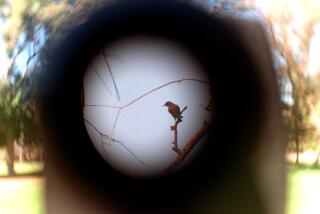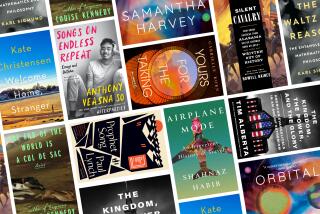Insiderâs Tuscany With an Outsiderâs Objectivity
WITHIN TUSCANY: Reflections on a Time and Place by Matthew Spender (Viking, $27.50 hardback).
At first glance, the reader might mistake this volume for an Italian variation on Peter Mayleâs immensely popular books about the south of France. âDoes for Tuscany what Mayle did for Provence!â . . . that sort of thing. But âWithin Tuscany,â a closer look soon reveals, is not that sort of thing at all.
Matthew Spender (poet Stephen Spenderâs nephew) is an English painter-turned-sculptor. In the late 1960s, he and his wife, herself a painter, moved to Tuscany--âon a whim, tired of the thin blue light of London town.â The Spenders planned to spend a year or two abroad. But, he notes, âWe must have had feet that rooted easily,â and they have stayed there ever since, in a farmhouse near Siena, raising two Tuscan-born daughters (Saskia and Cosima) and becoming bona fide members of the local community. He even plays clarinet with the village band.
The result of what might be called his immersion in Tuscany is that Spender writes about this most attractive part of Europe not as an observant traveler and not as an almost-newcomer still charmed by local ways (in the Mayle style), but as an intelligent and sensitive translator of the place--a man who speaks both languages, as it were. He has an insiderâs knowledge and appreciation of Tuscany, that is, but still retains at least a measure of the outsiderâs objectivity--and of a good guideâs awareness of his audienceâs interests.
Spenderâs prose suggests a sculptorâs, appropriately enough--skillfully but sometimes roughly chiseled--and he takes Tuscan history, art, politics, music, agriculture, romance and sex, among other things, as his subjects. Events as he recounts them sometimes take a surrealistic turn: In one chapter, a Roman film producer of his acquaintance asks Spenderâs assistance in arranging to shoot a soft-core movie in and around the neighborhood church of San Giusto. The script at one point calls for the heroine to writhe around atop bags of rice. Spender explains this episode to the priest in charge of San Giusto. âDon Osvaldo,â he writes in telling of the incident, âhas acquired over the years a magnificent simplicity when it comes to worldly matters. âNot in church, I hope,â he said, when I had finished. âPeople might be surprised to find a lot of bags of rice in a Romanesque chapel.â â
LOS ANGELES by Gil Reavill (Compass American Guides, $14.95 paper) ; and NEW MEXICO by Nancy Harbert (Compass American Guides, $15.95 paper).
These are the two latest titles in Compassâs lively, intelligent and literally color-bright Discover America series. (Other guides treat San Francisco, Las Vegas, Arizona, Colorado, Montana, Utah, Wyoming and Canada.) The Compass books in general are reminiscent of the Singapore-produced Insight Guides in their extensive use of color and their (successful) attempts to evoke the spirit of the places they deal with. They have their own personality, though, incorporating history, personal opinion, borrowed insight and a variety of visual effects, as well as all the usual touristic information. In the present cases, Reavillâs view of L.A. is learned, quirky and largely Hollywood-flavored (though not objectionably so)--and will delight and at least occasionally surprise even those of us who live here. Harbertâs take on New Mexico, meanwhile, is thoughtful and respectful; she manages to compress a great deal of complex historical and cultural information into readable paragraphs. Mark S. Wexlerâs photographs for the Los Angeles volume are particularly striking, and are well used; Michael Freemanâs for the New Mexico guide are lovely but less dramatic, and nowhere near as much fun.
EXPLORING KIRYU, ASHIO AND NIKKO: Mountain Walks in the Land of Shodo Shonin by Michael Plastow (Weatherhill, $19.95 paper).
Shodo Shonin was an 8th Century ascetic priest (âIt is perhaps impossible now to judge exactly what Shodo and his followers believed,â notes the author) who founded temples and shrines in the mountains north of Tokyo, and whose legend lives on to this day in the region. Plastow makes Shodoâs territory sound pristine, mysterious and highly attractive. It becomes all the more attractive when we learn that it may be reached in about two hours by train from Tokyo--and that walks as short as 15 minutes in duration can give the visitor at least a taste of the local landscape. Longer treks, involving some of the regionâs many waterfalls, temples, shrines and gardens, are outlined too. This is an expensive book, considering its modest size, but could prove invaluable to the Japan-bound nature-lover.
BIRDERâS GUIDE TO FRANCE by the Ligue Francaise pour la Protection des Oiseaux (French League for the Protection of Birds), translated by Tony Williams (Gulf Publishing, $16.95 paper).
Region by French region, this little volume offers brief portraits of quarries, gorges, lakes and other sites where birds flock, including basic maps, notes on access by car and by foot and seasonal bird calendars (black-headed gulls in winter, pied flycatchers in spring in the Bois de Boulogne). If you are a birdwatcher, or even an occasional glancer at birds, and are going to France, I canât imagine why youâd leave your nest without it.
More to Read
Sign up for our Book Club newsletter
Get the latest news, events and more from the Los Angeles Times Book Club, and help us get L.A. reading and talking.
You may occasionally receive promotional content from the Los Angeles Times.







